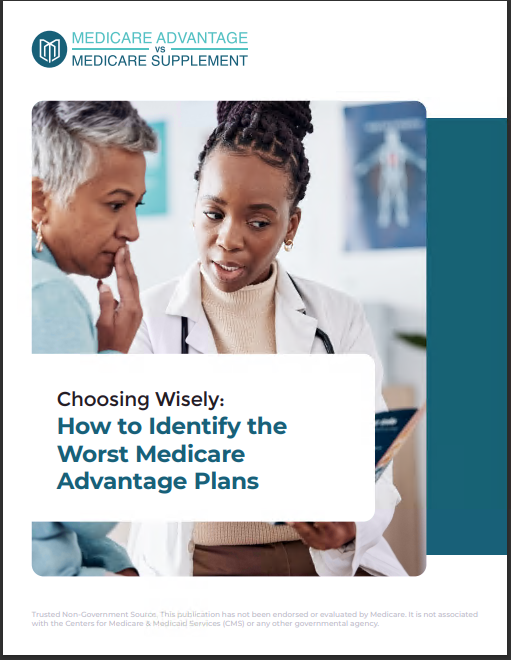Key Takeaways:
- Medicare Advantage plans can offer attractive benefits but often come with limitations, hidden costs, and restrictions that require careful consideration.
- Always read the fine print to fully understand coverage details, network limitations, and out-of-pocket expenses, as these can significantly impact your healthcare experience and costs.
Decoding Medicare Advantage: Beyond the Basics
When you first explore Medicare Advantage plans, they can seem like a simple, all-inclusive alternative to Original Medicare. These plans combine hospital, medical, and often prescription drug coverage into one. But what’s behind the glossy appeal? What are you really signing up for?
Medicare Advantage plans, also known as Part C, are offered through private insurance companies and regulated by Medicare. While they might seem straightforward at first glance, the devil is in the details—details that are often buried in fine print.
Let’s explore the essential factors you need to watch for before enrolling.
Coverage Limits Aren’t Always Obvious
What Looks Comprehensive Might Have Gaps
Medicare Advantage plans are known for bundling services, but they’re not always as inclusive as they appear. Coverage is often geographically restricted, meaning you might not have access to in-network care if you’re outside your plan’s service area.
Emergency services are typically covered nationwide, but routine or specialized care outside your network could leave you footing the bill. This is especially important if you travel frequently or live part of the year in another state.
Watch Out for Narrow Networks
Unlike Original Medicare, which allows you to see any provider that accepts Medicare, Medicare Advantage plans usually limit you to a network of doctors and hospitals. Before signing up, ensure your preferred healthcare providers are included in the network. Switching doctors mid-year can be both inconvenient and expensive.
Understanding Costs: The Fine Print Revealed
Not Just the Premium
While Medicare Advantage plans may advertise lower premiums than Original Medicare combined with Medigap and Part D, there’s more to the story. Costs like copayments, coinsurance, and deductibles can add up quickly, especially if you need frequent care or expensive treatments.
For example, some plans charge higher copays for specialist visits, hospital stays, or high-tier prescription drugs. Always review these potential costs in the plan’s Evidence of Coverage (EOC).
Out-of-Pocket Maximums Can Be Misleading
Medicare Advantage plans are required to have an annual out-of-pocket maximum, which is reassuring in theory. However, these caps can still be quite high, and they don’t include expenses like your monthly premium or out-of-network costs.
Make sure you understand what counts toward this limit and whether your typical healthcare needs are covered within that range.
Prescription Drug Coverage: Digging Deeper
Formularies Change Often
Most Medicare Advantage plans include Part D prescription drug coverage, but they’re not all created equal. Formularies (the list of covered drugs) vary significantly between plans and can change each year.
Even if your medications are covered this year, there’s no guarantee they’ll remain on the list. Carefully review the formulary for your medications and check for potential restrictions, such as prior authorizations or step therapy requirements.
Beware the Donut Hole
While the Part D coverage gap (donut hole) has been shrinking, it still exists in some Medicare Advantage plans. If you require high-cost medications, you could find yourself paying a larger share of the cost during this phase of coverage.
Additional Benefits: Are They Worth It?
What’s Advertised vs. What You Get
Medicare Advantage plans often advertise extras like dental, vision, hearing, and wellness programs. While these perks are appealing, the actual coverage is often limited.
For example, a dental benefit might only cover routine cleanings and exams but exclude more costly procedures like root canals or dentures. Always verify the specifics of any additional benefits to avoid surprises.
Hidden Costs of Extras
Even when additional benefits are included, there may be associated fees or restrictions. For instance, gym memberships might only apply to certain facilities, or vision benefits may only cover specific types of lenses or frames.
The Annual Enrollment Cycle: Stay Vigilant
Timelines You Can’t Ignore
Medicare Advantage plans change yearly, so even if your current plan suits you, it might not next year. The Annual Enrollment Period (AEP) from October 15 to December 7 is your chance to review and adjust your plan.
Failure to review updates to coverage, costs, and provider networks could leave you stuck with a plan that no longer meets your needs.
Special Enrollment Periods
Certain life events, like moving or losing other insurance coverage, may qualify you for a Special Enrollment Period (SEP). These events allow you to switch plans outside the AEP, but the rules and timelines can be strict.
Reading the Fine Print: A Crucial Step
Why It’s Non-Negotiable
The fine print isn’t just legal jargon—it’s where the most critical details about your plan are outlined. This includes exclusions, prior authorization requirements, and the processes for appealing denied claims.
Take the time to read the plan’s Summary of Benefits, Evidence of Coverage (EOC), and Annual Notice of Change (ANOC). These documents explain what’s covered, what’s not, and how your plan may change in the upcoming year.
Questions to Ask Yourself
- Are there any coverage exclusions for services I frequently use?
- Does the plan have any prior authorization requirements that could delay care?
- How does the plan handle claims disputes?
Having clear answers to these questions before enrolling can save you frustration later.
Know Your Rights and Protections
The Appeal Process
If your Medicare Advantage plan denies coverage for a service, you have the right to appeal. This process can be complex, so it’s essential to understand your rights upfront.
The plan’s EOC will outline the steps for filing an appeal and the timeline for resolution. Make sure you keep detailed records of all communications and decisions related to your appeal.
Disenrollment Rules
If you’re unhappy with your plan, you’re not necessarily stuck. During the Medicare Advantage Open Enrollment Period (January 1 to March 31), you can switch to another Medicare Advantage plan or return to Original Medicare.
Making the Best Decision for Your Needs
Medicare Advantage plans can be a good fit for some people, but they’re not one-size-fits-all. Your health needs, financial situation, and personal preferences should all factor into your decision.
Taking the time to carefully review your options, compare costs, and read the fine print will help ensure you choose a plan that works for you—not against you.
Why Your Choice Matters for Long-Term Healthcare
Choosing a Medicare Advantage plan is more than a decision about healthcare; it’s a commitment that impacts your access to providers, the quality of care, and your financial stability. By approaching the decision thoughtfully and staying informed, you can avoid pitfalls and ensure your coverage aligns with your needs.










